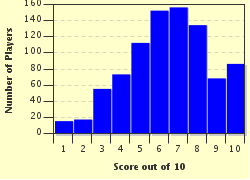Quiz Answer Key and Fun Facts
1. The first page that I came across dealt with the Upazila of Hizla, located in an Asian country that contains the delta of the Brahmaputra and Ganges Rivers. That low-lying country, which has very fertile farmland, has often been subject to flooding, especially in 2007. In what country would you find the 200-square-mile subdistrict of Hizla?
2. The next random page that I come to is about the novel "De Perfil" by acclaimed author Jose Agustin. Unfortunately, Agustin is perhaps not as well-known as his compatriot authors Octavio Paz, Carlos Fuentes, and Juan Rulfo. In what country, whose vast literary tradition includes books like "The Labyrinth of Solitude" and "The Old Gringo," does "De Perfil" take place?
3. Apparently, the relationship between two completely-different countries was significant enough to merit its own page on Wikipedia. The page details both an embassy in Athens and the visit of one country's Prime Minister to Rio de Janeiro in 1999. "Bilateral relations that have always been good and are progressing smoothly" describe the foreign alliance between which two nations?
4. Any article on defunct Australian currency is going to absolutely put me to sleep, but I was surprised by an interesting fact on a page about the Australian Sixpence coin, which was first minted in 1910 and continued as a coinage past decimalization in 1966. During World War II, the letters "S" and "D" were added to the coins, indicating what interesting fact?
5. Ever heard of the character in Greek myth known as Athis? He was mentioned briefly in Ovid's "Metamorphoses" when he was slain by a major Greek hero. Athis was killed in a battle that also saw Phineus, the betrothed of Andromeda, being turned to stone by a decapitated Gorgon's head. What hero slew Athis and married Andromeda?
6. It seems like Wikipedia has articles on every single genus of animal ever discovered, so it was no surprise when I came to a page about the genus Petaurus, also known as the "flying phalangers." Those organisms live primarily in Australia and New Guinea, and they represent a major taxon of marsupials. Which of the following is an organism in the Petaurus genus?
7. In Belarusian, it's "Kalfin i Gopsya." In Finnish, it's "Lassi ja Leevi." In Norwegian, it's "Tommy og Tigern," and apparently, some people call it "Kelvin and Celsjusz" in Poland. Either way, foreign translations of which Bill Watterson comic strip are apparently considered didactic material?
8. My favorite random article of all detailed the historical and cultural impact of a major world religion on a European country. Beginning in 964 by the visit of Ibrahim Jaqub, history continued when, during Suleiman's siege of Vienna, several Sunnis made it to Moravia. In more modern history, a mosque was first built in Brno in 1988. What not-very-notable topic did this article discuss?
9. I finally came across a topic that I at least knew something about, a science-heavy description of the Mossbauer Effect, important in a branch of physics called spectroscopy. The namesake German physicist noticed that high-energy radiation could experience resonance only in solids, not gases, which led him to conclude that sometimes, recoil has no effect in solids. What type of radiation, which has extremely high energy and short wavelength, was Mossbauer studying?
10. Clicking "random article" one last time brings up a page about Edwin Hughes, who is notable for being the last survivor of "the noble six hundred," many of whom were massacred on October 15, 1854 during the Battle of Balaclava. What military disaster did Hughes survive before his death in 1927?
Source: Author
adams627
This quiz was reviewed by FunTrivia editor
Pagiedamon before going online.
Any errors found in FunTrivia content are routinely corrected through our feedback system.

